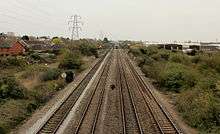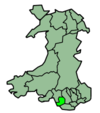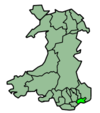South Wales Main Line
| South Wales Main Line | |
|---|---|
|
The entrance to the Severn Tunnel on the English side | |
| Overview | |
| Type | Heavy rail |
| System | National Rail |
| Status | Operational |
| Locale |
South Wales South West England |
| Stations | 18 |
| Operation | |
| Opened |
1850 (Chepstow-Swansea) 1903 (Swindon-Patchway) |
| Owner | Network Rail |
| Operator(s) |
Arriva Trains Wales CrossCountry Great Western Railway |
| Character | Main line |
| Technical | |
| Line length | 84.38 miles (135.80 km) |
| Number of tracks | Mainly double track, though quadruple track from Severn Tunnel Junction via Newport to Cardiff Central. |
| Track gauge | 4 ft 8 1⁄2 in (1,435 mm) standard gauge |
| Electrification |
25kV 50Hz AC OHLE (Wootton Bassett to Cardiff Central by 2017 & Swansea by 2018) |
The South Wales Main Line (Welsh: Prif Linell De Cymru), originally known as the London, Bristol and South Wales Direct Railway or simply as the Bristol and South Wales Direct Railway, is a branch of the Great Western Main Line in Great Britain. It diverges from the core London-Bristol line at Royal Wootton Bassett near Swindon, first calling at Bristol Parkway, after which the line continues through the Severn Tunnel into South Wales.
Great Western Railway operates High Speed Trains between London and South Wales and services between Cardiff and South West England. CrossCountry provides services from Cardiff to Nottingham via Severn Tunnel Junction and thence the Gloucester to Newport Line via Gloucester and Birmingham. Arriva Trains Wales operates services between South Wales, and North Wales and the Midlands on the line.
It is planned to electrify the line using the AC overhead system, with completion by 2018.
History
The original route of the Great Western Railway (GWR) between London and South Wales, after the opening of Brunel's Chepstow Railway Bridge in 1852, left the Bristol-bound Great Western Main Line at Swindon, proceeding via Stroud, Gloucester and Chepstow before rejoining the line as we know it today at Severn Tunnel Junction. This gave rise to the nickname 'Great Way Round'.
In 1886, the opening of the Severn Tunnel brought the opportunity of a more direct route to South Wales, and trains from Swindon to Newport and beyond were routed via Bristol and the Severn Tunnel. This route leaves the one we know today at Royal Wootton Bassett near Swindon rejoining it close to Patchway station.
The route used today was established in 1903 with the building of what is often known as the 'Badminton Line'.[1] This involved the construction of about 33 miles (53 km) of new track including two tunnels at Alderton and Sodbury between Royal Wootton Bassett and Patchway. Not only did this provide a more direct route for traffic to and from South Wales, the gradient was easier for coal trains to negotiate, and it was thought that the line would be a boost to what was, at the time of building, the expanding port of Fishguard. This was the GWR's connection with trans-Atlantic ocean liner departures.
Infrastructure

There are four tracks from Severn Tunnel Junction through Newport to Cardiff Central, with two tracks on the remaining sections.[2] Multiple-aspect signals are controlled from several power signal boxes including Swindon, Bristol and two in Cardiff. Over the August Bank Holiday weekend 2016 control of the signals between Westerleigh Junction and Pilning was switched over to the Thames Valley Signalling Centre. These signals now carry the prefix 'BL'.
The maximum line speed from London to Coalpit Heath is 125 mph (200 km/h); 90 mph (145 km/h) from Coalpit Heath to Newport; 90 mph (145 km/h) from Newport to east of Bridgend;[3] 75 mph (120 km/h) from east of Bridgend to Swansea Loop North junction (with a small section of 100 mph (160 km/h) track through Pyle station); and 40 mph (65 km/h) from Swansea Loop North Junction to Swansea.[2]
Associated routes
A diversionary route exists if the Severn Tunnel is closed. This takes trains from Severn Tunnel Junction to Gloucester, from where they can rejoin the main line either by the Golden Valley Line to Swindon, or the Cross-Country Route and reverse at Bristol Parkway.
If the line is closed between Cardiff Central and Bridgend, an alternative route exists along the Vale of Glamorgan Line.
Half of peak High Speed Trains and most off peak trains continue from Cardiff Central to Swansea, with a few continuing to Carmarthen or in summer, Pembroke Dock.
The local service between Swansea and Cardiff is branded Swanline. The urban network within and surrounding Cardiff, including the Maesteg Line, is referred to as Valley Lines.
Plans
Traffic levels on the Great Western Main Line are rising faster than the national average, with continued increases predicted. The now defunct Strategic Rail Authority produced a Route Utilisation Strategy for the Great Western Main Line in 2005 to propose ways of meeting this demand, Network Rail plan to implement a new study in 2008. In the meantime, their 2007 Business Plan includes the provision of extra platform capacity at Cardiff Central, Newport and Bristol Parkway, also resignalling and line speed improvements in South Wales, most of which would be delivered in 2010–2014.
Reading railway station is currently undergoing a major redevelopment and there is a proposed future link to Heathrow Airport directly from Reading under the Heathrow Airtrack scheme.
Electrification
The South Wales Main Line is one of the last of the major inter-city routes in Great Britain to remain un-electrified. The government announced in July 2009 a scheme to electrify the South Wales Main Line as part of a wider scheme of electrification on the Great Western Main Line. By 2017, the line from London to Cardiff will be electrified.[4]
The new Hitachi Super Express trains planned for the Great Western inter-city services will now be predominantly electric units instead of the planned diesel units. However, a proportion of the fleet will be using dual power source electro-diesel bi-mode trains, which will enable services to operate before line electrification is complete. The bi-mode trains will allow inter-city services to operate from London all the way to Carmarthen in the future. The new Super Express trains will bring about an estimated 15% increased capacity during the morning peak hours. Electrification will cut journey times between Swansea and London by an estimated 20 minutes, although electrification will not extend west of Swansea to Carmarthen or Pembroke Dock, and services on the line to Brighton, Portsmouth Harbour and Taunton will continue to be operated by diesel trains, as the Bristol to Exeter Line and the Wessex Main Line will not be electrified.[4]
Communities served
|
|
Accidents and incidents
- On 7 March 2015, Battle of Britain-class locomotive 34067 Tangmere was hauling a charter train that overran a signal at Wooton Bassett, Wiltshire. The train's operator, West Coast Railway Company was banned from running trains on the British railway network as a direct consequence of this incident.
See also
References
- ↑ Kevin Robertson and David Abbott (1988). GWR The Badminton Line – A portrait of a railway. Sutton Publishing Ltd. ISBN 0-86299-459-4.
- 1 2 "Network Rail – Wales Route Utilisation Strategy (November 2008)" (PDF). Retrieved 2013-09-16.
- ↑ Network Rail. "Network Rail: Route specifications 2011" (PDF). Network Rail. Retrieved 22 March 2015.
- 1 2 "Britain's Transport Infrastructure, Rail Electrification" (PDF). Department for Transport. Retrieved 2013-09-16.
- Network Rail Passenger Timetable. London: Network Rail. 2006.
External links
| Wikimedia Commons has media related to South Wales Main Line. |
- 2007 Business Plan, Network Rail, London








